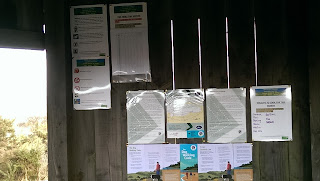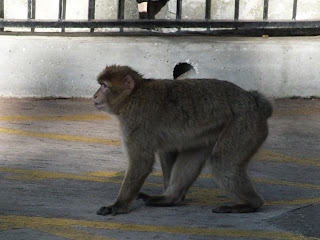Pembrey Burrows & Saltings Local
Nature Reserve
Ringing report
& wildlife notes 2015
prepared by, Paul Aubrey :
January 2016
Overview
Ringing
commenced at the Pembrey Burrows LNR in mid October 2015. It always take time
to establish the best locations for setting mist nets at a new site; 2016 will
bring consistency to the locations used.
Being a
coastal site ringing is very dependent on the weather especially the strength
of the wind and anything over 9 miles per hour effectively cancels any attempt
at ringing.
In total
10 ringing sessions took place between October and December 2015 with a total
of 105 birds ringed of 18 species.
There are
three main areas where the mist nets are set,
·
The
Willows/Reed Bed opposite the Welsh Water, treatment works.
·
The
area of Sea Buckthorn along the hard track from the cattle pens to the first
stile into field 2.
·
The
area of Sea Buckthorn and Gorse around the observation hut at the end of the
hard track. (these areas of scrub are grouped s one site for reporting
purposes).
Additional ringing opportunities exist near each of the three
artificial ponds as well as on the salt marsh and the high water mark on Cefn
Sidan beach.
Ringing summaries by location
Place Totals Summary Sea Buckthorn &Scrub
Retraps/
Full
grown Pulli Recoveries Total
2015
Jack Snipe 1 0 0 1
Tree Pipit 1 0 0 1
Meadow Pipit 11 0 0 11
Wren 4 0 1 5
Dunnock 8 0 0 8
Robin 9 0 0 9
Blackbird 8 0 0 8
Song Thrush 4 0 0 4
Redwing 7 0 0 7
Goldcrest 8 0 3 11
Firecrest 1 0 0 1
Blue Tit 10 0 0 10
Great Tit 3 0 0 3
Chaffinch 6 0 0 6
Goldfinch 5 0 0 5
Reed Bunting 5 0 1 6
Total 91 0 5 96
Place Totals Summary Willows and Reed Bed
Retraps/
Full
grown Pulli Recoveries Total
2015
Willows/Reed Bed
Wren 3 0 0 3
Dunnock 1 0 0 1
Robin 1 0 0 1
Chiffchaff 2 0 0 2
Goldcrest 1 0 0 1
Blue Tit 2 0 0 2
Magpie 1 0 0 1
Chaffinch 1 0 0 1
Reed Bunting 2 0 0 2
Total
14 0 0 14
14 0 0 14
Highlights of 2015
The undoubted
highlights for a new ringing site were Jack Snipe Lymnocryptes minimus, and Firecrest Regulus ignicapilla
Both these birds were
unexpected and provide evidence of the wide variety of bird species which use
the reserve.
 |
| Jack Snipe |
A Reed Bunting
"controlled" i.e. already ringed by another ringer and then caught at
Pembrey LNR, was originally ringed at Oxwich Marsh NNR in September 2015.
The commencement of
ringing at Pembrey LNR offers the opportunity for a long term ringing scheme to
become established, although it will take several years of consistent ringing
to provide a truly useful dataset, each year will bring value by providing factual, science based, data of the
ornithological interest of the site which over time will provide valuable
information to help structure the long term management of the reserve.
Ringing is a proven
method for establishing, amongst others information on, population structure,
site fidelity, and longevity, given the wide range of species already recorded
in the three months that I have been involved in the reserve the scope to
discover more is huge.
Having a "ringing
station" at Pembrey LNR enhances the network of coastal ringing stations,
from Skokholm Island in the West to
Cardiff Bay in the East.
Wildlife notes
As I am on site as the
volunteer ranger at least three/four times a week, I am able to record my own
observations as well as gather
information from visitors.
Notable
bird records between September and December 2015:
Raptors and Owls
Buzzard,
Red Kite (2), Hen Harrier, Common Kestrel, Sparrowhawk, Merlin, Peregrine, Barn
Owl and Short-eared Owl (2) [the SEO were a visitor record]
Maximum Counts of Wildfowl*
Teal (300+),
Pintail (13), Wigeon (15), Shelduck (2), and Red-breasted Merganser
Waders of note*
Common
Snipe, 40+ flushed by Hen Harrier on 4th December 2015, Redshank 41, Curlew 28,
Green Sandpiper 2 (on 28th November 2015).
*many
more birds are probably out of sight in the creeks.
Mammals
The
following mammals have been observed,Red Fox, Badger, Weasel, Rabbit, Wood
Mouse, Field Vole, Mole Common Shrew and Hare
( a Leveret about four months old
was seen on 3rd November 2015, and an adult was seen by a visiting naturalist
in mid December 2015). Otter: I found signs of feeding, (crab shells and limbs)
on the bank of one of the salt marsh creeks in late November 2015, (and smudged
foot prints in late December) an adult
has been seen in the harbour at Burry Port on a number of occasions. The
scrubby areas provide ideal "lying up" habitat for these elusive
mammals
Of interest
Of
particular note were a juvenile Common Cuckoo on the late date of, 7th October
2015, and a Barn Swallow on the very late date of 30th November 2015. Late
season butterflies were a Comma seen on
1st November 2015 and a Red Admiral on 22nd November 2015; contrasting with the wintering flock of some 2000+
Common Starlings feeding on the Salt Marsh.
























